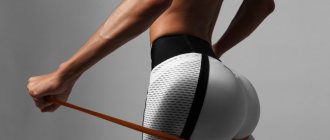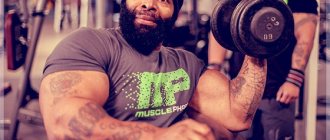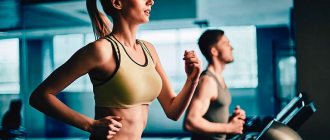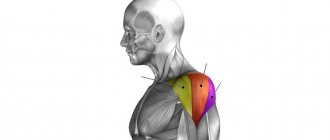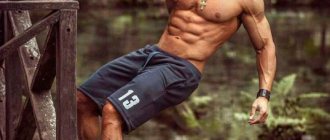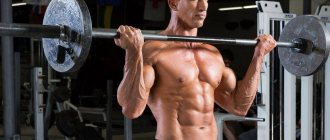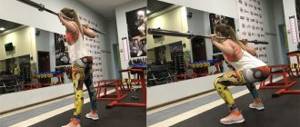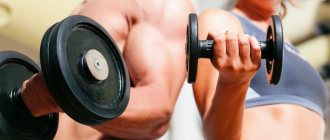Updated June 25, 2020 Beautiful, sculpted abs are probably the surest sign of a man who takes care of his figure. Even seasoned adherents of the heavy “base” look sideways with envy at their colleagues with cubes. Although women do not strive for pronounced relief, they try to make their stomach toned and flat. Abdominal exercises in the gym will help both guys and girls achieve their goals.
Anatomy of the press
Sometimes practice without theory also means a lot. But it is better to preface work on muscles with a theoretical basis. This will allow you to train your abs with understanding.
The abdominal muscles belong to the “core” muscles, forming a muscular corset together with the muscles of the hips and buttocks. Press tasks:
- hold and protect internal organs;
- form the abdominal wall;
- shape posture and stabilize the body.
If the back in the central zone of the body is stabilized by the spine, then in the front you can only rely on the strength of the abdominal muscles. You may not need a sculpted belly, but an even posture is definitely necessary. And with a weak press, over time the spine moves the body forward - a stoop appears. A trained press is a matter of aesthetics, functionality, and health.
The abdominal muscles consist of:
- rectus muscles;
- internal and external oblique muscles;
- transverse muscles.
The anatomy of the press is the same for everyone. But each has its own characteristics that affect the shape of the abdominal muscles. Some workouts will give you the classic bulging 6-pack, while others will have to be content with just a “flat” hint of them. There's no way to fix this with exercise, but targeted exercise will help you get the most out of your abs.
Rectus abdominis muscle
This is a flat and long muscle, the bundles of which are separated by several transverse tendon bridges. Extends from the sternum to the pubic bone. Vertically - into right and left zones - the rectus muscle is divided by a layer of connective tissue. The degree of convexity and the pattern of the abdominal fascicles depend on the attachment of the longitudinal and transverse tendons.
Purpose of the rectus muscle:
- the possibility of “contact” of the pelvis and chest - twisting of the body in the lumbar area;
- lifting the pelvis with a fixed sternum;
- exhale and lower the ribs;
- increased intra-abdominal pressure.
Oblique muscles
The external obliques are located on both sides of the straight line, effectively outlining the central zone. Start from the lateral region of the chest. They are attached from above to the eight lower ribs, and from below to the pubic bone.
Main functions:
- body rotation left and right;
- lifting and moving weights;
- body flexion;
- fixation of the body in a vertical position.
The internal oblique muscles are located under the external obliques. They form the second layer of the abdominal cavity and are distinguished by fan-like tufts. The latter run from the ilium diagonally upward towards the central line.
Purpose:
- body rotation;
- bending the torso to the side;
- pulling the sternum down;
- abdominal compression.
Transverse muscles
These muscles form the deepest layer of the abdominal muscle corset. They run like a belt around the internal organs located in the abdominal area.
Main functions:
- exhale and tighten the ribs;
- reduction in waist size;
- turning the body to the sides;
- frontal flexion of the body.
How a woman can pump up her abdominal muscles in the gym
The main condition for training for women is not to be afraid to pump up your body. The hormone testosterone, the level of which in the female body is minimal, is responsible for large and prominent muscles in men.
For this reason, you will not be able to pump up your abs or arms even if you really want to.
The abdominal muscles consist of large longitudinal and lateral muscles. It is not worth dividing the press into lower and upper, since in any exercise these zones are used simultaneously.
For a comprehensive workout, use various crunches, loads with dumbbells and fitballs, additional weights for the legs, etc.
Note! Women should not get carried away with exercises for the lateral abdominal muscles - training them can significantly increase their waist size.
When training your abs, don’t forget about:
- Warm up. Before starting each lesson, do warm-up exercises (running, jumping) for 15 minutes. This warming up of the muscles not only protects them from injury, but also increases the effectiveness of the entire training.
- Correct breathing. It should be deep and measured. Do not hold your breath even at moments of extreme muscle tension. Timely saturation of muscles with oxygen improves their functions.
- Drinking plenty of water. During active training of the abs and other areas, you should drink at least 0.5 liters of clean, non-carbonated water.
- Comfortable equipment. Clothes for the gym should be comfortable and not restrict movement. It is not recommended to use shapewear or various belts during training - they can impair local blood circulation.
The best abdominal exercises in the gym
You can train your abdominal muscles at home. And in general in any conditions. But abdominal exercises in the gym allow you to work out your muscles comprehensively and more efficiently. In this section we will look at a number of the most useful and effective exercises. But first, a few recommendations.
No matter how trained the muscles are, their effectiveness depends on the amount of fat deposits. Many athletes have treasured abs, but those around them don’t even know about it.
In order to demonstrate the presence of powerful abs to yourself and others, you need to burn fat. You can't do this with just training - you need a diet.
The best abdominal exercises in the gym must be combined with a healthy diet. These two pillars complement each other and allow you to acquire expressive abs in a relatively short time.
It is better to train the abdominal areas in this order:
- lower press;
- upper press;
- oblique muscles.
The upper and lower abs are one large rectus muscle. The division is conditional - certain movements allow you to give a more concentrated load to the areas. The training order is logical, since the lower zone is weaker. By loading it second or third, you waste more energy. Of course, there are exceptions to this rule. You can and should start from the bottom, for example, if you pay close attention to this part of the abdomen.
Upper abs exercises
To begin with, we’ll tell you about the technique of performing the most effective exercises that help keep your upper abdominal muscles toned.
Incline crunches
Along with crunches while lying on the floor, this is a classic “animal” exercise. These two crunch variations are the most effective abdominal exercises in the gym, targeting the upper abdominal area. Performed on a bench with an inclination angle of 30-45 degrees. Beginners can set a smaller angle.
Technique:
- starting position – back and pelvis on a bench, legs fixed with bolsters (knees above head), hands behind head or in front of you;
- raise your head and shoulders, and then, with a twisting movement, try to bring your chest closer to your knees; rise as long as tension is maintained in the press;
- Pausing for a moment at the peak point, smoothly lower; You don’t need to lower yourself to IP, but to a position in which tension is not lost; you don’t need to put your back on the bench.
These are not sit-ups, but crunches. The exercise should be performed in such a way as to minimize the participation of the lower back and hips - all attention to the abs.
Crunches using a block
Among the basic abdominal exercises in the gym is an exercise that resembles the bows of a praying person, which is why it is called “prayer.” In fact, these are ordinary crunches on a block machine. It can be performed while standing, but the classic version involves performing it on your knees.
Execution scheme:
- starting position – kneeling (on the floor or bench) facing the block; arms bent at the elbows hold the handle of the block exercise machine;
- holding the block, while exhaling, using the strength of your abdominal muscles, bend your body forward, as if making a bow;
- return to IP.
The hands are used only for fixing the projectile, the pelvis and legs are used for support. Almost the entire load should fall on the press. First, it is recommended to master the exercise with a very light weight. Once the mechanics of the movement are felt and the muscles are strengthened, you can add weight. The starting weight for a beginner is within 10 kg.
Crunches on a fitball
We recommend a good selection of abdominal exercises on a fitball. The characteristics of a fitball - a training ball - allow you to work your abs at non-standard angles. The mobility of the ball engages the stabilizer muscles - hence the benefits that are difficult to obtain with the help of other simulators.
Technique:
- starting position – lying with your back on a fitball; the back and pelvis rest on the ball, the legs are hanging, slightly apart, the feet rest firmly on the floor; hands behind the head or in front of the chest;
- lift your body so as not to tear your lower back from the projectile;
- return to IP.
Twisting while hanging upside down
Hanging upside down crunches are an exercise for trained athletes. Not suitable for beginners.
Technique:
- starting position – hanging on the crossbar upside down, with slightly bent legs; back straight, arms behind head or in front of chest;
- as you exhale, lift your torso up with a twisting motion; the buttocks also rise a little;
- while inhaling, gently lower your torso; if there is a swing, you need to linger a little at the bottom, extinguishing it.
Full amplitude is of no use here. It is much more important to achieve strong tension. Therefore, it is recommended to raise the body until it is parallel to the floor. Athletes who have mastered the option of loading with their own body can use weights.
Crunches in the simulator
Every more or less equipped gym has a special abdominal machine. This is an exercise in the gym for girls - the abs are also loaded in men, but more often women use the equipment.
Execution scheme:
- starting position – hands hold the handles, legs are fixed with bolsters;
- Tightening your abs, simultaneously twist your upper back and lift your legs;
- After pausing for a second in the climax phase, return to the IP.
The advantage of the simulator is that the load on the lower back is reduced. But it still remains if you fall too deep in the recovery phase. Bend to a position in which your back does not experience discomfort.
Lower abs exercises
To train the lower abs, the exercises below are best suited, which are performed exclusively with your own weight.
Hanging Leg Raises
Exercises for the lower abs in the gym almost always include this, the classic one. It can be performed either without weights or with additional weight. Whether to use weights or not depends on the level of preparation.
Execution scheme:
- starting position - hanging on the crossbar or resting your elbows in a special simulator; legs down;
- as you exhale, raise your legs until they are parallel to the floor; stay in this position for a moment; trained athletes can only slightly bend their knees, but for beginners it is better to bend them more strongly - it’s easier to do so;
- return to IP.
Hanging reverse crunches
The exercise is in many ways similar to the previous one, but here a twisting movement takes place. The kind described in the section on straight crunches. The starting position is the same as when lifting the legs while hanging. But you need to raise your legs not along an angular trajectory, but along a rounded one, twisting. This puts more tension on the muscles.
Classic reverse crunch
It can be performed both at home and in the gym - lying on the floor or bench.
Technique:
- starting position - lying on a bench or floor; It is better to keep your hands along the body - this allows you to feel the movement; when practicing on a bench, you need to hold on to the top of the bench;
- lift your legs up, focusing on your abdominal muscles; The lower back needs to be raised slightly - this will cause the abdominal muscles to contract more strongly;
- smoothly return your legs and lower back to a position close to the IP; You shouldn’t let your abs relax, you shouldn’t lower your legs to the floor – the muscles should be under constant load.
Since these are twisting movements, the mechanics of movement are similar - along a rounded path. As your physical capabilities increase, you can use additional weights.
Oblique exercises
Among the exercises that give the greatest load specifically to the oblique abdominal muscles, we have selected the 3 most effective.
Oblique crunches
There are several options for performing oblique twists. You can perform the exercise either lying on the floor or lying on a bench.
Traffic scheme according to the traditional version:
- starting position - lying on the floor, legs “looking” to the right or left and bent at the knees;
- as you exhale, slightly raising your shoulders, using the force of your oblique muscles, lift your body with the twisting movement you already know;
- trying to fix your torso at the peak point for a second, then smoothly return it to the IP.
This variation of crunches is technically more difficult than most abdominal exercises in the gym. Therefore, special attention must be paid to technology. Do not press your chin to your chest, and do not pull your elbows and head behind your body.
"Woodcutter"
Like “prayer,” this exercise is performed in a block. Allows you to feel and work out your lateral abs very well.
Technique:
- starting position – standing sideways to the simulator; the right hand holds the block, the left helps it - both hands are at the top;
- rotate the body, slightly tilting it, towards the left leg; block pulls must be performed with the strength of the oblique abdominal muscles;
- return to IP.
After this, you need to repeat the exercise for the right side. In this case, the block is held by the left hand.
Side bends with weights
For this exercise, you need to take heavier weights, otherwise the lateral press will not react. You can do it either one by one - with one projectile - or simultaneously, holding the projectiles in both hands. You can use dumbbells or kettlebells.
Scheme for sequential execution:
- starting position – standing with dumbbells in your right hand; the left hand is lowered or behind the head;
- lean to the left side, contracting the oblique muscles as much as possible;
- return to IP.
Then do a set for the opposite side.
Of course, these movements do not exhaust the options. But the exercises described are the most popular, and exotic exercises can be done after mastering the classics.
Gym training program for girls
Since the anatomical abs are no different for boys and girls, abdominal exercises for women in the gym are the same as for men. Generally. There are minor practical differences:
- there is no need to use heavy weights;
- Fitballs and exercise machines are used more often;
- schemes with a large number of repetitions are used more often; repetition is the key to weight loss and a flat stomach.
An approximate set of exercises for women in the gym:
| Exercise | Target | Scheme |
| Crunches on a fitball | Upper press | 2-3 sets of 15-25 reps |
| Crunches in the simulator | Upper press | 2-3 sets of 12-15 reps |
| Hanging leg raises with emphasis on the elbows | Lower press | 2-3 sets of 10-20 repetitions |
| Side crunches | Side press | 2-3 sets of 12-15 reps |
The number of approaches and repetitions depends on the level of preparation and training goals. If your abs are strained after hard work on other muscle groups, there is little point in doing a lot of exercises and repetitions. If the activity is targeted, and the athlete is more or less experienced, the complex can be diversified and expanded.
Abdominal training machines
Abdominal exercise machines will help develop and strengthen your abdominal muscles.
It should be remembered that additional equipment will not reduce belly fat, it will only strengthen the muscles in this area. If you want to get defined muscle definition, adjust your diet to reduce your overall body fat content.
- A Roman bench is a board with an adjustable incline. A plane with an inclination of 45 degrees will allow you to perform twists as efficiently as possible.
- A seated crunch machine will allow you to work out your abdominal muscles and is recommended for people with problems in the cervical spine.
- The roller is useful for maintaining good abdominal shape and can be used on both the obliques and rectus muscles.
- The hanging leg raise bar engages the shoulders in addition to the abdominal muscles.
- The fitball is useful for balance and core exercises. Crunching exercises can also be performed using a fitball.
- Exercise machine with rubber loops - this device will add resistance to exercises with leg raises to work the abdominal muscles.
- A separate article is devoted to the plank exercise.
For home exercises, you can purchase a Roman bench and a roller for effective abdominal training. Crunches can also be done on the floor without the use of additional equipment. To complicate the exercises, weights in the form of dumbbells or a barbell plate are often used.
Press program in the gym for men
On average, men have less body fat than women. Therefore, they need an emphasis on heavy load rather than on the number of repetitions.
An approximate men's abdominal exercise program in the gym:
| Exercise | Target | Scheme |
| Incline crunches | Upper press | 2-3 sets of 15-20 repetitions |
| "Prayer" | Upper press | 2-3 sets of 12-15 reps |
| Hanging reverse crunches | Lower press | 2-3 sets of 10-15 reps |
| "Woodcutter" | Side press | 2-3 sets of 12-15 reps |
And finally, a few recommendations. It is better to load the abs at the end of the workout. It is recommended to rest for a minute between approaches - the abdominal muscles recover quickly. You don’t need to train your abs every day; they also need rest. The recommended number of repetitions should correspond to a load close to failure. This means that the tension should be such that by the last repetition you can no longer perform another one. Or at least they could have done it with great difficulty.
Alternatively, you can perform the complex in a circular fashion - one exercise after another. Then a new circle. In this case, the rest between approaches/exercises is minimal. Rest between circles – a minute or two.
Is it possible to lose weight and get lean with such loads?
Physical exercise helps strengthen muscles and increase their tone. At the same time, it is impossible to remove fat only with the help of strength exercises; a proper diet is necessary.
A balanced diet when losing weight involves getting enough nutrients to feel good and gradually reducing calories. To lose weight, you need to eat 10-15% fewer calories than you burn. Active workouts contribute to more active calorie consumption.
Also, performing abdominal exercises allows you to tighten the contours of your abdomen and improve blood circulation in this area. With regular physical activity, the weight loss process takes less time, and progress is clearly visible after 1-2 months.
Note! You should not pump your abs every day - this will not speed up the weight loss process, but can cause muscle fatigue. Perform exercises in this area about 3 times a week, taking a break for 1-2 days to recuperate.


